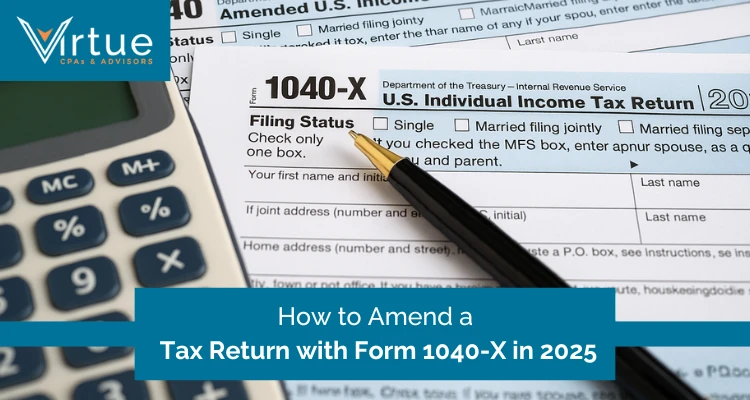You might be reading this because you just realized — oh no — you made a mistake on your tax return.
Maybe you forgot to include some interest income, or claimed a deduction incorrectly, or left off a dependent.
The good news is you can fix that by filing an amended return using Form 1040-X.
Whether you’re an individual filer, a freelancer, a small business owner, or someone who simply wants peace of mind that your taxes are accurate.
In this article, you’ll learn step by step how to amend your return in 2025, what to watch out for, and how Virtue CPAs can help you get it done correctly.
Purpose of Form 1040-X
Form 1040-X is the IRS’s official form for amending a previously filed individual income tax return. Use it when you need to correct or update a Form 1040, 1040-SR, or 1040-NR.
You can also use it to make a claim for carrybacks (for example, unused credits or net operating losses), or to change amounts already adjusted by the IRS.
When You Should File an Amendment
You should file a Form 1040-X when you discover an error or omission in your originally filed return, such as:
- You forgot to report additional income (a missing 1099, interest, dividends).
- You claimed a deduction or credit you were ineligible for, or you missed one you were eligible for.
- You had the wrong filing status or an incorrect number of dependents.
- You got corrected tax documents (e.g., an amended W-2 or corrected 1099) after your original filing.
- You need to correct items that the IRS adjusted on your behalf.
But you don’t use 1040-X for every mistake — for example, mathematical or clerical errors are often corrected by the IRS automatically.
When Not to File a 1040-X
There are three situations where you should not file a 1040-X form to amend a tax return.
- Don’t use 1040-X for simple math errors: the IRS often corrects those itself.
- If your original return isn’t yet processed or accepted, wait before amending.
- If a state-level amendment is needed, you’ll need to file that separately (see below).
Deadlines & Statute of Limitations
Timing matters. For most taxpayers, you have to file your amendment within:
- Three years from the date you filed your original return (including extensions), or
- Two years after the date you paid the tax for that year (whichever is later.)
If you’re outside these windows, in most cases, you can’t claim a refund via amendment.
E-Filing vs. Paper Filing
One of the newer changes is that in 2025 (and recent years), the IRS allows you to electronically file a Form 1040-X — for the current or up to two prior tax periods — using authorized tax software.
However, if your original return was filed on paper (for older years), or the year is beyond the two prior periods, you may still need to submit the amendment on paper.
Preparing to Amend: What to Gather Before You Start
Before you even open Form 1040-X, you want to get organized. A little prep goes a long way.
Documents Checklist
Make sure you assemble:
- Your original tax return (Form 1040, schedules, worksheets)
- All supporting documents you omitted or corrected (W-2s, 1099s, K-1s, etc.)
- Any IRS notices or adjustments sent to you
- Documentation for deductions or credits you now want to claim
- Past tax returns (if the amendment spans multiple years)
- Bank or routing information (if your amended refund is to be directly deposited)
Having everything at hand ensures you won’t have to reopen the form midway.
Identify What Is Changing
Be clear about exactly what you want to correct. Is it:
- Income (you missed reporting something)
- Deductions or credits (you misestimated or omitted)
- Filing status or dependent count
- Adjustments or carrybacks
Be precise, because your whole amendment will revolve around those changes.
Determine the Affected Forms / Schedules
Whatever changes you make, other parts of your tax return may also change. For example:
- If you adjust itemized deductions → Schedule A
- If you change business income → Schedule C, Schedule SE
- If capital gains change → Schedule D, Form 8949
- If credits change → the relevant credit form (e.g., education credits, energy credits)
Check State Tax Implications
Often, when you fix your federal return, you also need to amend your state tax return.
Rules differ by state — some allow only limited years, some don’t require amendment unless your state liability changes. Virtue CPAs can help you navigate both federal and state amendments.
Assess Whether It’s Worth It
Ask yourself:
- Will the extra refund or tax savings justify the effort?
- How large is the error?
- Are there risks (e.g, triggering IRS inquiries)?
- Do you have confidence in your documentation?
Sometimes small mistakes might not warrant a formal amendment — but in many cases, it’s worth correcting.
Timing Considerations
Don’t rush. Wait until your original return is fully processed and accepted by the IRS before filing your amendment.
Filing too early can cause confusion or rejection.
Step-by-Step Guide to Completing Form 1040-X
Now comes the core: filling out Form 1040-X. Let’s walk you through it.
Overview of Form Layout
Form 1040-X is structured with three columns:
- Column A: The amounts actually reported on your original return (or as adjusted by the IRS).
- Column B: The difference — how much you are increasing or decreasing those amounts.
- Column C: The correct, adjusted amount (Column A plus or minus Column B).
Lines 1 through 30 cover income, deductions, tax, payments, and refunds or amounts owed.
Understanding this structure helps you fill in carefully and avoid mistakes.
Filling Out the Key Sections
1. Lines 1–5 (Income, AGI adjustments)
- Start with what you reported (Column A).
- In Column B, enter the increase or decrease (for example, you forgot $500 of interest income).
- Column C becomes the corrected amount.
2. Lines 6–10 (Deductions, taxable income)
- If you switch between standard deduction or itemizing, your changes go here.
- Reflect changes in deductions or exemptions.
3. Lines 11–18 (Tax, credits, other taxes)
- Recompute tax based on your corrected taxable income.
- Recalculate credits (education, child, energy, etc.).
- Adjust “other tax” items if applicable (self-employment tax, alternative minimum tax, etc.).
4. Lines 19–22 (Payments, withholding, total tax paid)
- Update your withholding or estimated payments if necessary.
- Reflect overpayments or prior payments.
5. Lines 23–30 (Refund or amount you owe)
- This is where the difference is finalized.
- If your amendment increases your refund, that extra goes here.
- Or, if correction results in owing tax, this is where that shows.
As you go, make sure your math is consistent: Column A + Column B must equal Column C.
Part II – Explanation of Changes
Part II is crucial. This is where you tell the IRS why you made changes. Here are tips:
- Be clear and concise.
- Reference line numbers and forms (e.g., “Line 5, Column B: adding $300 interest income not included on original return”)
- Use bullet points or short paragraphs for readability
- State the original error, the correction, and the net effect
A strong explanation helps avoid back-and-forth requests from the IRS.
Part III – Banking Information (for Refunds)
If your amended return results in a refund and you’re eligible, you can request direct deposit for that refund.
In 2025, the IRS maintains this capability for amended returns for tax years 2021 and later.
Make sure to enter a valid routing and account number. If you use a paper-filed amendment, your refund typically comes via check.
Signatures and Attachments
- Signatures: The taxpayer (and spouse, if jointly filed) must sign. If a paid preparer helped, they must sign too and include their credentials.
- Attachments: Include any forms or schedules that changed, plus documentation for added income or deductions (corrected W-2, 1099 forms, receipts).
- Checklist: Before sending, double-check your math, your explanation, and whether all supporting docs are included.
Submitting Your Form
E-File Option
If your return year is within the current or two prior years and your tax software supports it, you can e-file the amended return.
E-filing may shave off a week or two in processing time since it eliminates mailing delays.
Paper Filing
If e-filing isn’t available, mail your Form 1040-X and attachments to the address listed in the IRS instructions (varies depending on where you live).
Use certified mail or tracking if possible — you want proof the IRS got it.
Only file the amendment after your original return has been processed.
After You File: What Happens Next
Once your amended return is off your desk, here’s what to expect:
Processing Timeline
- Typically, allow 8 to 12 weeks for the IRS to process your 1040-X.
- In some cases, it can take up to 16 weeks (or longer, depending on complexity).
- If there are issues (incomplete info, signature missing, IRS review), it may be delayed even further.
Tracking Status — “Where’s My Amended Return?”
You can begin tracking your amended return about three weeks after filing using the IRS’s tool “Where’s My Amended Return?”
That tool shows status updates like: Received, Adjusted, or Completed.
If it hasn’t shown a status after three weeks, don’t panic — sometimes delays happen due to system processing.
If the IRS Contacts You
If the IRS requests more information or sends a notice, respond promptly and clearly. Provide supporting documents and explanations. Keep copies of everything you send.
If adjustments are made by the IRS, they’ll let you know.
Sometimes your outcome changes from what you requested.
Refund or Balance Due
If your amendment yields a refund, the IRS will send you the additional amount (or the full adjusted refund) by check or direct deposit (if eligible).
If you owe additional tax, you’ll need to pay that, generally with interest and sometimes penalties.
Paying sooner can reduce interest and penalties.
Conclusion – Partner with Virtue CPAs for Peace of Mind
You now know the full journey of amending a tax return using Form 1040-X in 2025: when you should do it, how to fill it correctly, and what follows after filing.
While the process is manageable, mistakes or missing pieces can cause major delay or missteps.
That’s where Virtue CPAs comes in.
Our team is experienced in correcting tax returns, handling multi-year amendments, and navigating both federal and state requirements.
We stay current with IRS policies, software capabilities, and procedural changes for 2025, so you don’t have to.
If you’re unsure, overwhelmed, or just want confidence that your amendment is right, contact Virtue CPAs for a free consultation.
Let us help you file your Form 1040-X accurately, reduce errors, and maximize your rightful refund or reduce liability.






